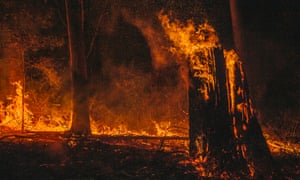
Fire crews and townspeople on the mid-north coast of NSW are reeling with exhaustion, heartache and fear
by Michael McGowan in Taree, pictures by Jessica Hromas
by Michael McGowan in Taree, pictures by Jessica Hromas
At a Rural Fire Service base in the village of Marlee on the New South Wales
mid-north coast this week, a young firefighter named Kieron Gatehouse
tried to describe what it looks like when a mountain catches fire.
“Tuesday night was the craziest shit I have ever seen,” he tells Guardian Australia.
“There’s a big mountain you can normally see over there, you can’t tell because of the smoke, but on Tuesday night it had flames licking 60 metres, 70 metres off the top of it. Easy.
“You can’t, you can’t even describe. Like a giant ball of fire. There were 50-metre gum trees with flames just licking off the top. The biggest flames I have ever seen.”
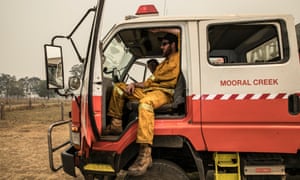
“Tuesday night was the craziest shit I have ever seen,” he tells Guardian Australia.
“There’s a big mountain you can normally see over there, you can’t tell because of the smoke, but on Tuesday night it had flames licking 60 metres, 70 metres off the top of it. Easy.
“You can’t, you can’t even describe. Like a giant ball of fire. There were 50-metre gum trees with flames just licking off the top. The biggest flames I have ever seen.”

“We’re exhausted. It’s been 15-, 16-hour days since it started, but we’ve going since mid-June on and off. There’s some very, very tired crews around.”
Across the state, four people have died and more than 250 homes have been destroyed after a week in which hundreds of bushfires burned through more than 1m hectares.
It has left communities like Marlee exhausted, anxious and fearful of what is still to come.
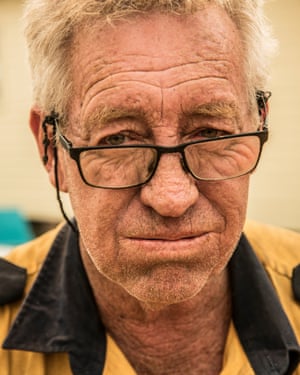
“It hasn’t stopped, and we don’t know when it will,” teacher Barb
Cameron says as she prepares lunch for the firefighters inside the
Marlee community hall on Thursday.
When people first started evacuating from the usually lush green hills surrounding the village on Friday last week, Cameron and her sister-in-law, Jennie Cameron, walked outside and saw people wandering the street.
So they turned the hall into an unofficial evacuation centre and started feeding people. A week later they haven’t stopped. They speak in rapid-fire sentences running over the top of one another, afraid to sit down in case they can’t get up again.
Much of this district is still without power or phone service, and the hall has turned into both a hub of information and a reprieve from the scorched earth that surrounds it.
“We came in thinking we would pack up today,” Jennie says. “But people kept showing up.”
There is a temptation, in reporting, to place events within a linear arc. The fire, the devastation and the recovery. But one of the first things you notice when talking to people who have felt the fire’s full force this week is the way they speak about time.
Things seem to happen in non-sequential order. Events roll into one another. This smoke that hangs around them might as well have been here forever because there is only what happened, what is happening and what they fear is going to happen next.
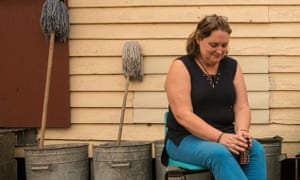
Barb Cameron takes a break from feeding firefighters and evacuees in Marlee, NSW. Photograph: Jessica Hromas/The Guardian
“Don’t ask me what day something happened because I don’t know what day it is now,” Cameron says.
After relatively benign weather on Thursday, by Friday the high temperatures and gusty wind had returned. More than 60 fires continued to burn, and half remained uncontained. The RFS issued an emergency warning for a fire near Lithgow in the Blue Mountains, then another for the village of Ebor near Armidale, and then two more soon after for the Richmond valley and a fire near Kempsey.
In Queensland there were more than 60 blazes still burning. Hundreds have been evacuated, and the drought-stricken Darling Downs and Granite Belt region, west of Brisbane, faces severe fire danger for at least the next three days.
This question of when it will end is playing havoc with people’s psyche.
Further south in the NSW suburb of Rainbow Flat, outside the town of Tuncurry where a number of properties were destroyed on Friday last week, Col Meredith still struggles to sleep.
Meredith is one of the few who stayed behind when the fires came through and despite helping protect his and a few neighbours’ homes, he feels guilty he wasn’t able to stop the fire tearing through a friend’s property.
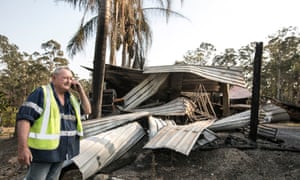
Col Meredith on his neighbour’s property in Rainbow Flat. The house was destroyed. Photograph: Jessica Hromas/The Guardian
A few days later he was still reliving Friday night. It was scary, he says, to watch the speed at which the fire moved up the ridge near his home.
“It’s an adrenaline rush, you know,” he says. “I slept four hours last night and that’s the most I’ve slept in days. I’m tired and I’m aching but I was still up at 5am.”
As debate raged about hazard reduction and whether or not it is OK to talk about the link between bushfires and climate change, swirling winds and high temperatures continued to plague fire crews after Tuesday’s “catastrophic” fire danger warning.
Guardian Australia watched on Wednesday as fire crews and residents in the rural suburb of Hillview, west of Taree, battled spotfires that broke out with terrifying frequency as the wind continued to change direction.
Meanwhile at the Taree showgrounds, where more than 1,000 people evacuated to on Tuesday, one woman held back tears as she talked of not being able to get the sound of cracking tree branches out of her head.
Another, Jane Davis, didn’t know whether her house in Hillview was still standing. The president of the Mid North Coast Canine Club, she’d kept busy looking after the dozens of dogs who’d been brought to the showgrounds.

A horse walks through its charred paddock in Hillville, NSW. Photograph: Jessica Hromas/The Guardian
“It’s helped me keep my mind off of it,” she says. “I’m sure I’ll have a breakdown soon. I’ve already had a few mini ones.”
A day later, as Bill Goddard cleared through rubble on his charred Hillview property with a friend, Aaron Swan, he gave a small cheer as his cat, named Cat, appeared for the first time since Monday.
“The silly bugger took off up a tree,” he says as he feeds him a slice of devon.
Goddard had been clearing land as the fire approached on Monday and hadn’t wanted to leave even as it licked at the boundaries of his property, but Swan had driven in and forced him to leave.
“I pretty much had to tie him to the lounge to stop him coming back on Tuesday,” Swan says.
“He got a bit quiet as we drove back here this morning, but he doesn’t say much about it. He’s a typical Australian bloke of his generation – too bloody tough for his own good.”
The small shed Goddard lives in was intact, but his neighbour a bit further up the hill had not been so lucky.
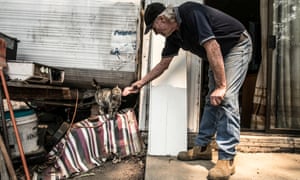
Bill Goddard welcomes Cat home with a slice of devon
after fire swept through his Hillview property. Photograph: Jessica
Hromas/The Guardian
The question of whether hazard-reduction burns raised its head often.
“They’re saying it’s the Greenies stopping us from doing these hazard-reduction burns,” one firefighter says. “It’s the lack of fucking resources and people to do it.
“No one joins up until the shit hits the fan.”
Munns, too, says it had simply been “too dry” to burn off during the winter.
“It was a very, very tight window,” he says. “And then in the small window we had we got a tiny, tiny bit of rain, which ruined us because it then it was too wet to do any burning.
“There’s one thing that’s going to stop all of this. It’s called rain.”
When people first started evacuating from the usually lush green hills surrounding the village on Friday last week, Cameron and her sister-in-law, Jennie Cameron, walked outside and saw people wandering the street.
So they turned the hall into an unofficial evacuation centre and started feeding people. A week later they haven’t stopped. They speak in rapid-fire sentences running over the top of one another, afraid to sit down in case they can’t get up again.
Much of this district is still without power or phone service, and the hall has turned into both a hub of information and a reprieve from the scorched earth that surrounds it.
“We came in thinking we would pack up today,” Jennie says. “But people kept showing up.”
There is a temptation, in reporting, to place events within a linear arc. The fire, the devastation and the recovery. But one of the first things you notice when talking to people who have felt the fire’s full force this week is the way they speak about time.
Things seem to happen in non-sequential order. Events roll into one another. This smoke that hangs around them might as well have been here forever because there is only what happened, what is happening and what they fear is going to happen next.

“Don’t ask me what day something happened because I don’t know what day it is now,” Cameron says.
After relatively benign weather on Thursday, by Friday the high temperatures and gusty wind had returned. More than 60 fires continued to burn, and half remained uncontained. The RFS issued an emergency warning for a fire near Lithgow in the Blue Mountains, then another for the village of Ebor near Armidale, and then two more soon after for the Richmond valley and a fire near Kempsey.
In Queensland there were more than 60 blazes still burning. Hundreds have been evacuated, and the drought-stricken Darling Downs and Granite Belt region, west of Brisbane, faces severe fire danger for at least the next three days.
This question of when it will end is playing havoc with people’s psyche.
Further south in the NSW suburb of Rainbow Flat, outside the town of Tuncurry where a number of properties were destroyed on Friday last week, Col Meredith still struggles to sleep.
Meredith is one of the few who stayed behind when the fires came through and despite helping protect his and a few neighbours’ homes, he feels guilty he wasn’t able to stop the fire tearing through a friend’s property.

A few days later he was still reliving Friday night. It was scary, he says, to watch the speed at which the fire moved up the ridge near his home.
“It’s an adrenaline rush, you know,” he says. “I slept four hours last night and that’s the most I’ve slept in days. I’m tired and I’m aching but I was still up at 5am.”
As debate raged about hazard reduction and whether or not it is OK to talk about the link between bushfires and climate change, swirling winds and high temperatures continued to plague fire crews after Tuesday’s “catastrophic” fire danger warning.
Guardian Australia watched on Wednesday as fire crews and residents in the rural suburb of Hillview, west of Taree, battled spotfires that broke out with terrifying frequency as the wind continued to change direction.
Meanwhile at the Taree showgrounds, where more than 1,000 people evacuated to on Tuesday, one woman held back tears as she talked of not being able to get the sound of cracking tree branches out of her head.
Another, Jane Davis, didn’t know whether her house in Hillview was still standing. The president of the Mid North Coast Canine Club, she’d kept busy looking after the dozens of dogs who’d been brought to the showgrounds.

“It’s helped me keep my mind off of it,” she says. “I’m sure I’ll have a breakdown soon. I’ve already had a few mini ones.”
A day later, as Bill Goddard cleared through rubble on his charred Hillview property with a friend, Aaron Swan, he gave a small cheer as his cat, named Cat, appeared for the first time since Monday.
“The silly bugger took off up a tree,” he says as he feeds him a slice of devon.
Goddard had been clearing land as the fire approached on Monday and hadn’t wanted to leave even as it licked at the boundaries of his property, but Swan had driven in and forced him to leave.
“I pretty much had to tie him to the lounge to stop him coming back on Tuesday,” Swan says.
“He got a bit quiet as we drove back here this morning, but he doesn’t say much about it. He’s a typical Australian bloke of his generation – too bloody tough for his own good.”
The small shed Goddard lives in was intact, but his neighbour a bit further up the hill had not been so lucky.

The question of whether hazard-reduction burns raised its head often.
“They’re saying it’s the Greenies stopping us from doing these hazard-reduction burns,” one firefighter says. “It’s the lack of fucking resources and people to do it.
“No one joins up until the shit hits the fan.”
Munns, too, says it had simply been “too dry” to burn off during the winter.
“It was a very, very tight window,” he says. “And then in the small window we had we got a tiny, tiny bit of rain, which ruined us because it then it was too wet to do any burning.
“There’s one thing that’s going to stop all of this. It’s called rain.”
No comments:
Post a Comment